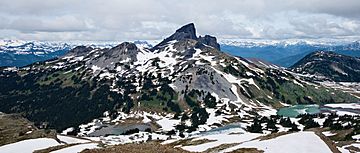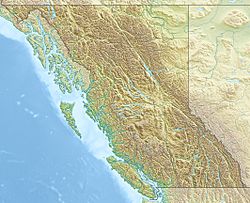The Black Tusk facts for kids
Quick facts for kids The Black Tusk |
|
|---|---|

The Black Tusk viewed from the southeast
|
|
| Highest point | |
| Elevation | 2,319 m (7,608 ft) |
| Prominence | 569 m (1,867 ft) |
| Geography | |
| Parent range | Garibaldi Ranges |
| Topo map | NTS 92G/14 |
| Geology | |
| Age of rock | Pleistocene |
| Mountain type | Stratovolcano |
| Volcanic arc/belt | Canadian Cascade Arc Garibaldi Volcanic Belt |
| Last eruption | Pleistocene |
| Climbing | |
| First ascent | 1912 by William J. Gray and party |
| Easiest route | Exposed rock scramble |
The Black Tusk is a cool-looking mountain in Garibaldi Provincial Park in British Columbia, Canada. It's actually an old stratovolcano, which is a type of volcano shaped like a cone. The mountain's pointy top is made of hard volcanic rock.
It stands tall at 2,319 meters (7,608 feet) above the sea. You can see its unique, dark spire from far away. It's especially easy to spot from the Sea-to-Sky Highway near Whistler. Because of its special shape, The Black Tusk is one of the most famous mountains in the Garibaldi Ranges. It is part of a group of volcanoes called the Garibaldi Volcanic Belt.
Contents
The Thunderbird's Home
The Squamish people, who are Indigenous to this land, have a special name for the mountain. They call it t'ak't'ak mu'yin tl'a in7in'a'xe7en.
In their language, this means "Landing Place of the Thunderbird". They believe a powerful, mythical bird called the Thunderbird lives there. The Squamish people say the mountain's jagged shape and dark color come from the Thunderbird's lightning.
How The Black Tusk Formed
The Black Tusk is what's left of an extinct volcano. This volcano formed a very long time ago, between 1.3 and 1.1 million years ago. Over time, ice and weather wore away much of the mountain.
Later, about 170,000 years ago, new lava pushed up. This created the hard rock at the very top of the mountain. Experts think The Black Tusk was like a pipe that carried hot lava inside a volcano. The softer, loose rock around it has since worn away. This left only the hard, black lava core we see today. This black, crumbling rock gives the mountain its name.
Glaciers and Plates
The mountain has two large glaciers on its sides. These glaciers start high up, around 2,100 meters (6,890 feet). They flow downwards, collecting lots of rocky bits from the crumbling mountain.
The Black Tusk is part of a chain of volcanoes that stretches from British Columbia down to California. These volcanoes formed over the last 35 million years. This happened because large pieces of the Earth's crust, called plates, are slowly moving. The Juan de Fuca Plate and other plates are sliding under the North American Plate. This process is called subduction, and it creates volcanoes.
Fun on The Black Tusk
The lower parts of The Black Tusk are a popular spot for hiking and scrambling. Scrambling means climbing over rocks using both your hands and feet.
Most hikers start their journey from the Taylor Meadows campground. This is located near Garibaldi Lake. There is also another path from the north, which goes past Helm Lake.
Reaching the Top
To reach the very top of the mountain, you need to be a skilled climber. The highest point is a tricky climb up a short, exposed rock section. This leads to the "south summit."
The true summit is just a little bit higher and across a dangerous drop. It's very rarely climbed because it's so difficult and risky. It involves rappelling down and then climbing up loose, crumbling rock. On the north side of the true summit, there's another challenging rock formation called the "Bishop's Mitre." It is said that no one has ever climbed it.
Images for kids
-
Part of the trail from Garibaldi Lake to The Black Tusk.
-
The Black Tusk as seen from the top of the Peak Express at Whistler Blackcomb





